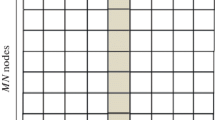Abstract
Fuzzy fusion is a technique, which, by using fuzzy rules at the data fusion center, improves the detection performance. In this paper, we analyze the FCA-CFAR, FGO-CFAR and FSO-CFAR detectors in homogeneous and Non-Homogeneous Weibull background for statistical MIMO radars. The non-homogeneity is modeled by the presence of a clutter edge in the reference window. For each detector, we derive the membership function and compute the threshold at the data fusion center. We apply the “Maximum”, “Minimum”, “Algebraic Sum” and “Algebraic Product” fuzzy rules for MN nodes at the fusion center. The obtained results showed that the best performance is obtained by the ‘Algebraic Product’ fuzzy rule. In the clutter edge case, the FSO-CFAR has the best false alarm rate control when the test cell is in the low level clutter, while when the test cell is in the high level clutter the FGO-CFAR performs better.










Similar content being viewed by others
REFERENCES
L. I. Ponomarev and A. I. Skorodumov, J. Commun. Technol. Electron. 54, 76 (2009).
C. Arunachalaperumal, C. Arun, S. Dhilipkumar, and G. Abija, J. Commun. Technol. Electron. 59, 1247 (2014).
H. M. Finn and R. S. Johnson, RCA Rev. 29, 414 (1968).
V. G. Hansen, in Proceedings of the IEE International Radar Conference, 1973, p. 325.
M. Baadeche, F. Soltani, and F. Gini, Signal Image Video Process. 13, 1677 (2019).
H. Rohling, IEEE Trans. Aerosp. Electron. Syst. 19, 608 (1983).
M. Baadeche and F. Soltani, Digital Signal Process. 44, 47 (2015).
J. A. Ritcey, IEEE Trans. Aerosp. Electron. Syst. 22, 443 (1986).
I. Ozgunes, P. P. Gandhi, and S. A. Kassam, IEEE Trans. Aerosp. Electron. Syst. 28, 1002 (1992).
M. Barkat and P. K. Varshney, IEEE Trans. Aerosp. Electron. Syst. 25, 141 (1989).
A. R. Elias-Fusté, A. Broquetas-ibars, J. P, Antequera, and J. C. M. Yuste, IEEE Trans. Aerosp. Electron. Syst. 28, 276 (1992).
M. K. Uner and P. K. Varshney, IEEE Trans. Aerosp. Electron. Syst. 32, 84 (1996).
Z. Hammoudi and F. Soltani, Signal Process. 84, 1231 (2004).
N. Janatian, M. Modarres-Hashemi, and A. Sheikhi, Circuits Syst. Signal Process. 32, 1389 (2013).
S. W. Leung, W. Minett, Y. M. Siu, and M. K. Lee, IEEE Trans. Aerosp. Electron. Syst. 38, 346 (2002).
Z. Hammoudi and F. Soltani, IEEE Proc. F, 151, 135 (2004).
H. A. Meziani and F. Soltani, Signal Process. 91, 2530 (2011).
F. Khaldi, F. Soltani, and M. Baadeche, J. Commun. Technol. Electron. 66, 62 (2021).
Y. Dong, Distribution of X-Band High Resolution and High Grazing Angle Sea Clutter, Defense Science and Technology Organisation (Edinburgh, South Australia, 2006).
A. Papoulis and A. B. Smith, Probability Random Variables and Stochastic Processes (McGraw-Hill, New York, 2002).
R. Ravid and N. Levanon, IEEE Proc. 139, 256 (1992).
Author information
Authors and Affiliations
Corresponding author
Ethics declarations
The authors declare that they have no conflicts of interest.
Rights and permissions
About this article
Cite this article
Maamar Abimouloud, Baadeche, M. & Soltani, F. CFAR Detection Performance in Weibull Clutter for Statistical MIMO Radar Using Fuzzy Fusion Rules. J. Commun. Technol. Electron. 66 (Suppl 2), S118–S125 (2021). https://doi.org/10.1134/S1064226921140011
Received:
Revised:
Accepted:
Published:
Issue Date:
DOI: https://doi.org/10.1134/S1064226921140011




